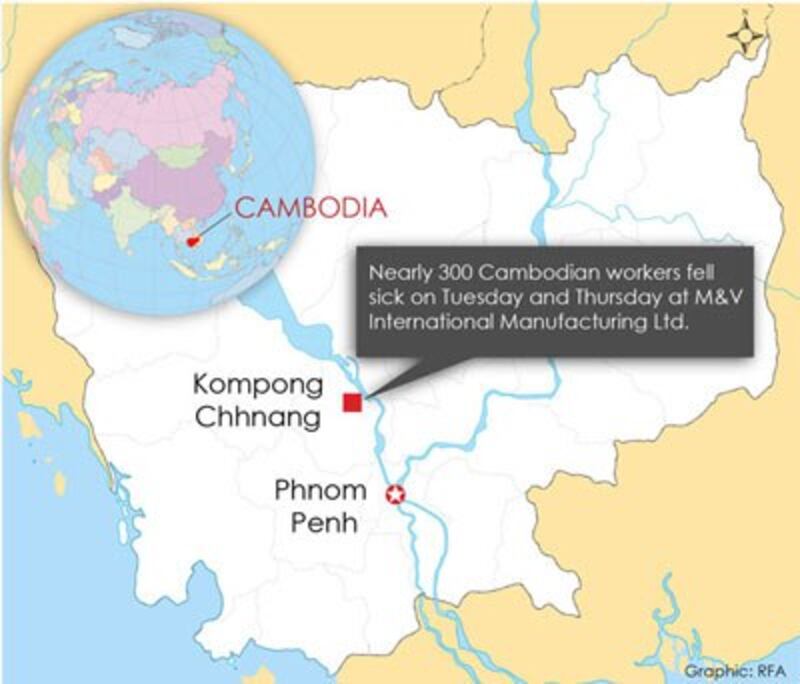Nearly 300 garment workers fell ill this week while laboring at a factory in Cambodia owned by a supplier to Swedish fashion brand H&M, raising concerns over mass faintings of factory workers in the country for reasons that have not been fully determined.
In the latest incident on Thursday, many of the estimated 200 fainted workers employed by M&V International Manufacturing Ltd at its factory in central Kampong Chhnang province reported an overpowering smell.
Ninety-eight workers had also collapsed at the factory on Tuesday, which a union representative said was due to forced overwork and fumes emitted by the building’s laundry room.
The factory management attributed the fainting to a “strange psychological phenomenon.”
The chief of the Provincial Department of Labor, Peou Sitha, said he had ordered the factory shut down until Monday to allow the 4,000 workers to rest and to give experts time to investigate the incident.

[ >>See the slideshow: Mass fainting at Cambodian factoryOpens in new window ]
Srey Leak, 26, one of the affected workers, said from the provincial hospital on Thursday that she watched workers in the factory’s Building L fall down, one by one.
She said she immediately began to feel ill and remembers nothing before waking up in her hospital bed.
“This workplace is not good at all. It’s hot and smelly. In addition to this, I was forced to work overtime,” she said.
“There is one big fan, but we were not allowed to open windows.”
Another worker, 20-year-old Sron Srey Noun, also said that conditions at the factory caused the workers to fall ill.
“To tell the truth, it was caused by the lack of fresh air to breathe … and the smell is unbearable. That was why I fainted,” she said.
This year alone, some 2,300 workers have reported fainting in five Cambodian factories for reasons that are not fully explained, Chea Mony, president of the Free Trade Union, one of Cambodia’s biggest independent unions, was reported saying last month.
An official at the Kampong Chhnang Hospital said 205 workers were transported to the hospital for treatment on Thursday.
But workers put the number who had fainted at more than 250, saying that many were not given medical care and instead were sent home to their families.
The head of Kampong Chhnang hospital, Surin Tiravuthy, said that by 2:30 p.m., the conditions of most workers had returned to normal and they were returned to their homes.
He said only 10 workers have required further treatment and remain at the hospital.
“Their condition is stable. The level of oxygen in their blood is normal … In general their conditions are good,” he said.
“The reason why they fainted … may have to do with being tired and not having enough to eat.”
‘Weak health’ to blame
Deputy provincial police chief Ly Virak told Reuters news agency that the mass faintings were a result of the "weak" health of the workers.
"When one worker collapsed, others also fell sick," he said.
A representative of the workers of the MV factory, Chuop Sam Ol, said that the fainting was due to panic brought on by the collapse of one worker on the first floor of Building L.
“It’s not a big problem. It was because the worker was weak. She did not sleep enough the night before. Her relatives were sick. She tended to them and had to stay awake. Therefore when she came to work in the morning she did not feel well,” she said.
“She works in Building L. Later, she collapsed. When the others saw this, they became panicked and started fainting one by one.”
An executive with M&V International Manufacturing Ltd told the Phnom Penh Post that allegations of forced overtime and a toxic working environment were untrue, adding that the fainting was caused by a “strange psychological phenomenon.”
“In China, this kind of thing is unthinkable. We can’t understand how this happens so often in Cambodia,” said the executive who asked to remain anonymous.
The factory is run by a Macau-owned company that produces items for several global brands, including Benetton and H&M. Its productions centers are in China and Cambodia.
"The workers don't pass out at once, they pass out in succession. One worker passes out, and when another sees this and she passes out, then another and another and another. It's beyond my comprehension."
Investigation underway
H&M told Reuters it was investigating the fainting and said the government, local authorities, and the U.N.’s International Labor Organization (ILO) had “not found any plausible causes so far.”
"The root cause of the mass faintings is difficult to establish," Hcan Andersson, an H&M spokesman, said in an e-mailed statement.
Earlier this month, the ILO carried out an inspection of the factory as part of its Better Factories Cambodia program.
ILO communications officer Ying Bun told the Phnom Penh Post that the factory would be inspected again.
The garment sector is Cambodia's third-largest currency earner after agriculture and tourism. Many of the workers labor long hours for meager salaries which are critical for hundreds of thousands of poor rural families.
In late 2009, officials vowed to crack down on safety violations that endanger factory workers after toxic fumes in a garment factory in Cambodia’s capital sickened hundreds of workers.
On Tuesday, environmental watchdog Greenpeace said in a report from Beijing that traces of toxic chemicals harmful to the environment and to human health had been detected in products made by 14 top clothing manufacturers.
Samples of clothing from top brands including Adidas, Uniqlo, Calvin Klein, H&M, Abercrombie & Fitch, Lacoste, Converse,and Ralph Lauren were found to be tainted with the chemicals, known as nonylphenol ethoxylates, the watchdog said at the launch of its report "Dirty Laundry 2."
Reported by Mondul Keo for RFA’s Khmer service. Translated by Vuthy Huot. Written in English by Joshua Lipes.
